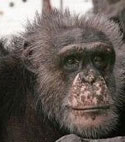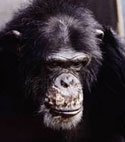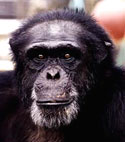
Chimpanzee, name unknown, demonstrating the trauma of HIV/AIDS research.
Photo: © Michael Nichols from Brutal Kinship (Aperture)
The use of chimpanzees in research was once hailed as “the key” for a cure to AIDS (Acquired Immune Deficiency Syndrome). Yet AIDS continues to kill millions of humans worldwide, despite the large number of chimpanzees that historically have been used in HIV/AIDS research.
Even recently, HIV research using chimpanzees represented only an extremely small, nearly non-existent percentage of chimpanzee use, if any at all, and a very small percent of all HIV research, an admission by scientists that the chimpanzee model of AIDS/HIV is a failure.
Given the lack of useful results, the use of chimpanzees in AIDS/HIV research can be considered a major debacle in chimpanzee suffering and a shameful waste of taxpayer dollars, scientific resources, and time in helping humans.
The beginning
In 1984, scientists started using chimpanzees in human immunodeficiency virus (HIV) experiments after discovering they could infect chimpanzees with HIV, the virus believed responsible for AIDS in humans.
The scientific community reacted with exuberance, launching the Chimpanzee Biomedical Research Program in 1986, specifically to breed large numbers of chimpanzees for HIV research. Many of those bred during this period account for what is now referred to as the chimpanzee “surplus.”
HIV: chimpanzee “infection” versus human infection
Scientists would ultimately learn that chimpanzees, (with one exception, Jerom, who did not suffer or die from AIDS but, after being infected with several different strains of the virus over a ten year period, did succumb to what researchers called an “AIDS-like” illness), do not contract AIDS from HIV infection. Instead they typically shed the virus in time (no longer testing positive), and exhibit other distinct differences from humans in response to HIV. Although HIV can replicate in their bodies, chimpanzees infected with HIV do not become sick with symptoms of HIV or AIDS. Yet, those pushing for their use went to great and invasive lengths—quite outside of the normal progression of the infection in humans—to attempt to force an HIV infection to progress to “AIDS-like” symptoms. For example, claims from Yerkes stated that “several…progressor” chimpanzees contracted AIDS. Yet they did not represent how the disease infects, progresses, or kills in humans.
HIV infection in chimpanzees results in viral plasma levels that decrease within two to three months of infection and become low to undetectable within a few years. After this initial period, the ability to detect the virus in the chimpanzee’s blood varies. (1)
Differences between human and chimpanzee HIV infection
- Humans become immunodeficient and do not maintain normal levels of critical immune factors, CD4 and T lymphocytes. Chronically infected chimpanzees maintain normal levels and do not become immunodeficient.
- In contrast to humans, HIV does not reproduce well in chimpanzees.
- Humans develop opportunistic infections and cancers associated with HIV; chimpanzees do not.
- Humans drop their antibody count prior to systemic illness; chimpanzees do not. (2)
Because of these significant disparities, HIV studies with chimpanzees have failed to produce a vaccine, treatment, or cure for AIDS. In fact, all vaccines that have proven safe and efficacious in chimpanzees (as well as other nonhuman primates) have failed in humans, with one in 2007 actually increasing a human’s chance of HIV infection. Admittedly, the HIV virus is very difficult to study, but using the wrong tool—the chimpanzee—has not helped scientists in their pursuits.
The wake-up call: CHIMP C499—Jerom
In 1996, Jerom died from an AIDS-like illness at the Yerkes Primate Research Center.
These results came about only after untold prior attempts to infect other chimpanzees in every conceivable way. Scientists had combined strains of the virus, used drugs to impair the chimpanzees’ immune function prior to HIV inoculation, and specifically destroyed the cells needed to protect the body from HIV. Researchers had even gone so far as to inject brain tissue from HIV-infected humans into chimpanzees’ brains without success of replicating the human disease. (3)
Jerom, also referred to by the serial number C499 by scientists at Yerkes, was a 14-year-old chimpanzee who had been infected initially at the age of two. Over the course of ten years, Jerom was infected with three different isolates of type-1 HIV. (4) These viral strains differ from the type that usually infects humans.
Jerom had to be euthanized when his condition became severe. After Jerom’s death, his blood was transfused into three other chimpanzees at Yerkes. Although they experienced a drop in CD4 counts, not one became sick or died.
A sharp decline in HIV/AIDS chimpanzee research
When Jerom’s infected blood failed to induce any significant illness in the other three chimpanzees, it served as a wake-up call to researchers using chimpanzees for HIV research. A drop in the number of HIV protocols with chimpanzees followed.
This line of research decreased dramatically from where it was at its peak of roughly 30 studies per year in 1998 to just four in 2005 and three in 2006-2007.
Fatal errors: ignoring differences
The flawed chimpanzee model of HIV not only failed to produce any sort of vaccine or treatment for HIV/AIDS, but actually contributed toward the suffering and deaths of thousands of citizens in France.
According to Claude Reiss, a leading French scientist:
In the early '80s, the observation that HIV does not affect the chimpanzee led ‘experts’ to assume that the virus is harmless to humans too. They consequently advised health authorities to allow transfusion with contaminated blood samples, the very cause of the French blood scandal that claimed thousands of innocent victims. (5)
In 1996, when the UK parliament attempted to assess the risk and containment of mad cow disease, Pierre Tambourin, then head of the life science department at the National Center for Scientific Research referred to the French blood crisis in his testimony:
What are the chances of developing a prion disease following ingestion of contaminated meat? Nobody knows, but we must not repeat the error we did in 1983-1985 with AIDS, when we referred to animal models to dramatically underestimate the risk to which humans are exposed. (6)
Chimpanzees and HIV/AIDS research
Meet some of the chimpanzees (left to right: Tom, Sue Ellen, Yoko, and Billy Jo) who were used in HIV/AIDS research and later rescued and moved to safety in sanctuary at Fauna Foundation. Photos: © Fauna
A large population of HIV-infected chimpanzees exists in the U.S. today due to their prior proposed use in HIV/AIDS experiments. An exact number is difficult to determine. According to a 1997 report prepared by NIH, “Although HIV infection of chimpanzees has not been an ideal model of disease, at least 198 chimpanzees have been used to date in HIV-related studies.” (7)
Eleven years after the launch of the chimpanzee breeding program to produce chimpanzees for AIDS research, NIH formally acknowledged the chimpanzee model of AIDS had been of limited success. In his testimony in 2000 before Congress, John Strandberg of NIH said:
Chimpanzees are the only animal, other than man, that can be infected with human immunodeficiency virus (HIV). For this reason, it was hoped that they could provide information on the progression from HIV infection to AIDS and in the development of treatments and vaccines. However, despite the fact that chimpanzees become persistently infected with HIV, we found that the development of clinical AIDS occurs in chimpanzees late or not at all. (8)
[It is unclear what Strandberg’s assessment of “occurs … late” is based on, given that only one HIV infected chimpanzee ever developed an “AIDS-like illness”.]
Wasted research dollars
Despite multiple admissions by NIH as well as other scientists that the chimpanzee model of AIDS had been unsuccessful, our government continued to fund HIV/AIDS research using chimpanzees. After Dr. Strandberg’s testimony before Congress, at least $10 million went to HIV experiments. In 2004, NIH funded four known protocols utilizing chimpanzees to study HIV at a cost of more than $2 million; that number rose to almost $3 million for just one research study in 2007.*
This cruel paradox is inadvertently best summarized in the words of Thomas Insel, MD, and former director of the Yerkes Regional Primate Center. He told a reporter in 1999:
I can’t tell you what it is that those [chimpanzee] studies have given us that has really made a difference in the way we approach people with this disease [HIV/AIDS]. (9)
*$2,569,447 for Grant U19AI074078, “HIV-1 VACCINE BASED ON CHIMP SEROTYPES OF ADENOVIRUS.”
Suffering in the name of science
An animal care technician at Yerkes, Rachel Weiss, was a caregiver for Jerom—the only chimpanzee ever to die of an “AIDS-like illness.” Deeply concerned by the day-to-day suffering of Jerom, she described his physical and emotional deterioration over many months:
As is often the case with experiments on live animals, Jerom suffered for much of his illness without being given medical treatment to relieve his pain or misery, because doing so would have interfered with the course of the experiment. I was with Jerom for his last six months. I was his caretaker and his nurse, and watched his decline just as I have watched human friends die of AIDS. My life has been profoundly affected by my work with Jerom and the other chimps he lived with. I write for Jerom because I was his witness. I write about Jerom because for me he has become a symbol of something greater, and while I harbor private memories and a profound sadness for the son/brother/patient I lost, I am filled with a sense of disgust which grows and will not be silent every time I hear of the latest cruelties committed in the name of humanity and in the name of science.
Instead of a proud figure, he was lean and gaunt, his hair dull, his skin pale, his eyes sunken from wasting and bright with fear and fever. He suffered in almost every way a caged chimpanzee can suffer, and then he died.
After his death, Rachel left her job at Yerkes to become an advocate against the use of chimpanzees in research. Each year on the anniversary of Jerom’s death, she calls attention to his and other chimpanzees’ plight by issuing a statement in memory of Jerom. The above words are from her memorial to him in 2000.
Read more about Rachel’s eyewitness experience with Jerom at Yerkes.
Sources
(1) Johnston MI. The role of nonhuman primate models in AIDS vaccine development. Mol Med Today. 2000 Jul;6(7):267-70.
(2) Americans for Medical Advancement, “AIDS Summary.”
(3) Fultz PN, McClure HM, Swenson RB, Anderson DC. HIV infection of chimpanzees as a model for testing chemotherapeutics. Intervirology 1989;30(suppl1):51-8.
(4) Sibal LR, Samson KJ. Nonhuman primates: a critical role in current disease research. ILAR J. 2001;42(2):74-84.
(5) Pro Anima Committee, “Doctors and Lawyers for Responsible Medicine against the Primate Center at the University of Cambridge.”
(6) Report 3291 of the National Assembly: From mad cow to scape cow; vol 2 (1996).
(7) National Resource Council (NRC), Institute for Laboratory Animal Research (1997). Chimpanzees in Research: Strategies for Their Ethical Care, Management, and Use, p. 17. Washington, DC, USA: National Academy Press.
(8) Testimony on Biomedical Research and Chimpanzees by John Strandberg, DVM., PhD, National Center for Research Resources, National Institutes of Health, U.S. Department of Health and Human Services Before the House Committee on Commerce, Subcommittee on Health and Environment May 18, 2000
(9) Smaglik, P. AIDS vaccine researchers turn from chimps to monkeys, The Scientist 13[16]:7, Aug. 16, 1999.
(10) Senate Report 110-410—DEPARTMENTS OF LABOR, HEALTH AND HUMAN SERVICES, AND EDUCATION, AND RELATED AGENCIES APPROPRIATION BILL, 2009. [Report to accompany S. 3230]. Available at https://www.thomas.gov/



